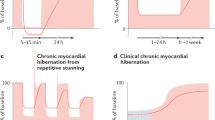Summary
When severely ischemic myocardium is reperfused, prolonged myocardial dysfunction—a phenomenon named myocardial stunning—frequently occurs. Stunning also occurs in a variety of other situations. These include myocardium located adjacent to infarcted tissue, transient increase in myocardial O2 demands in the presence of incomplete coronary obstruction, during both systole and diastole, in isolated perfused hearts rendered ischemir or anoxic, and in a variety of clinical situations, such as following ischemic arrest in cardiac surgery, thrombolytic reperfusion, and after episodes of severe ischemia in Prinzmetal's angina or unstable angina. Although the fundamental mechanism (s) responsible for myocardial stunning has not been elucidated, in experimental preparations calcium antagonists, free-radical scavengers, and neutrophil depletion have each been found to be helpful in minimizing it.
Similar content being viewed by others
References
Porter T. On the results of ligation of the coronary arteries. J Physiol (London) 1895;15:121.
Tennant T, Wiggers CJ. Effect of coronary occlusion on myocardial contraction. Am J Physiol 1935;112:351.
Heyndrickx GR, Millard RW, McRitchie RJ, et al. Regional myocardial functional and electrophysiological alterations after brief coronary occlusion in conscious dogs. J Clin Invest 1975;56:978–985.
Heyndrickx GR, Baig H, Nellens P, et al. Depression of regional blood flow and wall thickening after brief coronary occlusions. Am J Physiol 1978;234:H653-H659.
Kloner RA, Ellis SG, Lange R, et al. Studies of experimental coronary artery reperfusion: Effects of infarct size, myocardial function, biochemistry, ultrastructure, and microvascular damage. Circulation 1983;68 (Suppl I):8–15.
Ellis SG, Henschke CI, Sandor T, et al. Time course of functional and biochemical recovery of myocardium salvaged by reperfusion. J Am Coll Cardiol 1983;1:1047–1055.
DeBoer LWV, Ingwall JS, Kloner RA, et al. Prolonged derangements of canine myocardial purine metabolism after a brief artery occlusion not associated with anatomic evidence of necrosis. Proc Natl Acad Sci USA 1980;77: 5471–5475.
Braunwald E, Kloner RA. The stunned myocardium: Prolonged, postischemic ventricular dysfunction. Circulation 1982;66:1146–1149.
Rees G, Bristow JD, Kremkau EL, et al. Influence of aortocoronary bypass surgery on left ventricular performances. N Engl J Med 1971;284:1116–1120.
Chatterjee K, Swan HJC, Parmley WW, et al. Influence of direct revascularization on left ventricular asynergy and function in patients with coronary heart disease. Circulation 1973;47:276–286.
Matsuzaki M, Gallagher KP, Kemper WS, et al. Sustained regional dysfunction produced by prolonged coronary stenosis: Gradual recovery after reperfusion. Circulation 1987; 68:170–182.
Fedele FA, Gerwitz H, Capone RJ, et al. Metabokic response to prolonged reduction of myocardial blood flow distal to a severe coronary artery stenosis. Circulation 1988;78:729–735.
Rahimtoola SH. A perspective on the three large multicenter randomized clinical trials of coronary bypass surgery for chronic stable angina. Circulation 1985;72 (Suppl V): V123-V135.
Braunwald E, Rutherford JD. Reversible ischemic left ventricular dysfunction: Evidence for the “hibernating myocardium”. J Am Coll Cardiol 1986;8:1467–1470.
Rahimtoola SH. The hibernating myocardium. Am Heart J 1989;117:211–221.
Kloner RA, Przylenk K, Rahimtoola SH, Braunwald E. Myocardial stunning and hibernation: Mechanisms and clinical implications. Heart Dis. Clin. Update 1990;11:241–256.
Thaulow E, Guth BD, Heusch G, et al. Characteristics of regional myocardial stunning after exercise in dogs with chronic coronary stenosis. Am J Physiol 1989;257:H113-H119.
Bolli R, Patel BS, Hartley CJ, et al. Non-uniform transmural recovery of contractile function in stunned myocardium. Am J Physiol 1989;257:H375-H385.
Hittinger L, Shannon R, Kohlin S, et al. Subendocardial dysfunction during exercise and recovery in dogs with left ventricular hypertrophy (Abstr.). Circulation 1989;80 (Suppl II):298.
Nayler WG, Elz JS, Buckley DJ. The stunned myocardium: Effect of electrical and mechanical arrest and osmolality. Am J Physiol 1988;254:H60-H69.
Przyklenk K, Patel B, Kloner RA. Diastolic abnormalities of postischemic “stunned” myocardium. Am J Cardiol 1987;60:1211–1213.
Charlat ML, O'Neill PG, Hartley CJ, et al. Prolonged abnormalities of left ventricular diastolic wall thinning in the “stunned” myocardium in conscious dogs: Time course and relation to systolic function. J Am Coll Cardiol 1989;13: 185–194.
Zhao M, Ahang H, Robinson TF, et al. Profound structural alterations of the extracellular collagen matrix in postischemic (“stunned”) but viable myocardium. J Am Coll Cardiol 1987;10:1322–1334.
Arnold JM, Braunwald E, Sandor T, et al. Inotropic stimulation of reperfused myocardium: Effects on infarct size and myocardial function. J Am Coll Cardiol 1985;6:1026–1034.
Becker LC, Levine JH, DiPaula AF, et al. Reversal of dysfunction in postischemic stunned myocardium by epinephrine and postextrasystolic potentiation. J Am Coll Cardiol 1986;7:580–589.
Braunwald E. The stunned myocardium: Newer insights into mechanisms and clinical applications. J Thorac Cardiovasc Surg 1990;100:310–311.
Patel B, Kloner RA, Przyklenk K, Braunwald E. Postischemic myocardial “stunning”: A clinically relevant phenomenon. Ann Intern Med 1988;108:626–628.
Cohen M, Charney R, Hershman R, et al. Reversal of chronic ischemic myocardial dysfunction after transluminal coronary angioplasty. J Am Coll Cardiol 1988;12:1193–1198.
Krause SM, Jacobus WE, Becker LC. Alterations in cardiac sarcoplasmic reticulum calcium transport in the postischemic “stunned” myocardium. Circ Res 1989;65:526–530.
Przyklenk K, Kloner RA. Superoxide dismutase plus catalase improve contractile function in the canine model of “stunned myocardium”. Circ Res 1986;58:148–156.
Bolli R, Jeroudi MO, Patel BS, et al. Marked reduction of free radical generation and contractile dysfunction by antioxidant therapy begun at the time of reperfusion. Evidence that myocardial “stunning” is a manifestation of reperfusion injury. Cir Res 1989;65:607–622.
Engler RL, Schmid-Schonbein GW, Pavelec RS. Leukocyte capillary plugging in myocardial ischemic and reperfusion in the dog. Am J Pathol 1983;111:98–111.
Przyklenk K, Kloner RA. Effect of verapamil on postischemic “stunned” myocardium: Importance of timing of treatment. J Am Coll Cardiol 1988;11:614–623.
Author information
Authors and Affiliations
Rights and permissions
About this article
Cite this article
Braunwald, E. Stunning of the myocardium: An update. Cardiovasc Drug Ther 5, 849–851 (1991). https://doi.org/10.1007/BF00053546
Issue Date:
DOI: https://doi.org/10.1007/BF00053546




